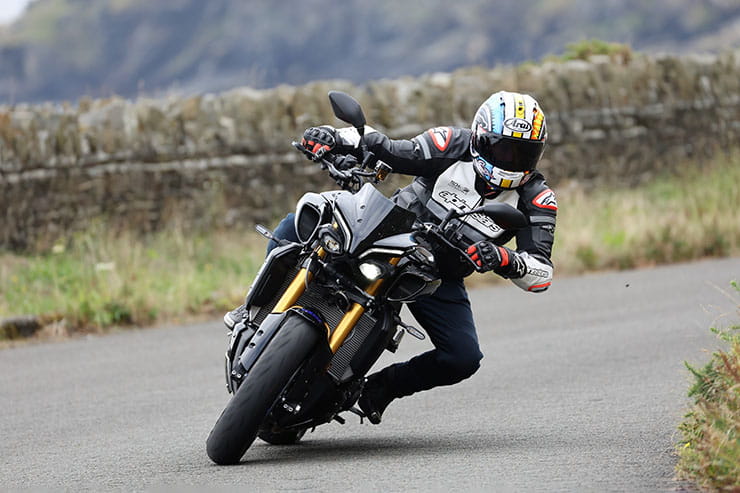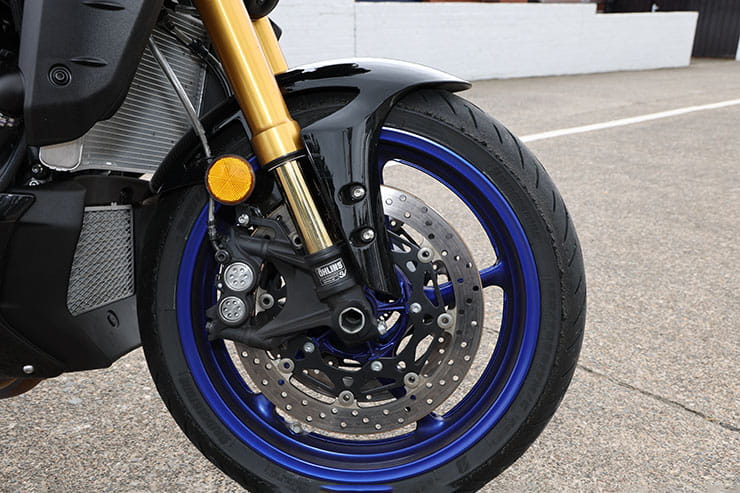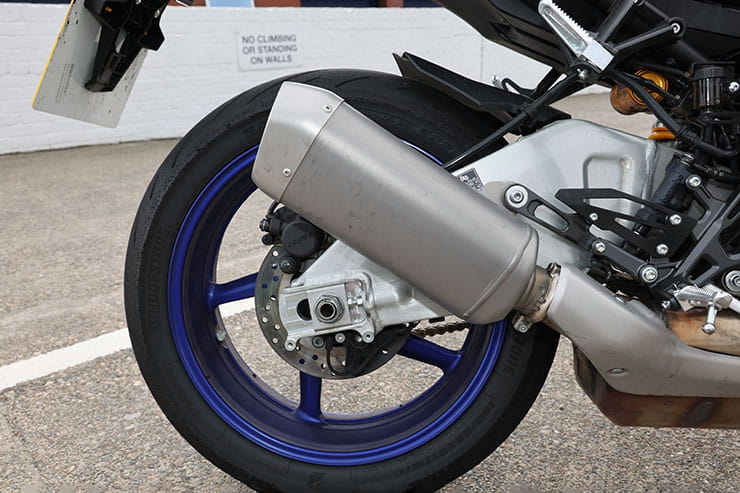Price: from £16,000 | Power: 164bhp | Weight: 214kg | Overall BikeSocial Rating: 4/5
Back in 2016 Yamaha introduced the pinnacle of its MT empire, the MT-10, and later the premium MT-10 SP. Transforming a crossplane R1 into a torque-rich sports naked bike was an obvious move. It was an instant success: fun, muscular, easy to ride and full of character other Japanese ‘hyper nakeds’ seemed to lack. It was reasonably priced too.
But in recent years the MT-10 has started to show its age, especially in terms of technology including its rider aids. It was always on the thirsty side, too, and by modern standards the brakes were lacking against newer, lighter rivals. It was time for an update, which is why for 2022 Yamaha introduced a new MT-10 earlier this year.
The engine, with that unique howl, was never a weak point but Yamaha did give the MT a little nip-and-tuck. Peak power has increased to 122kw (164bhp) at 11,500 rpm, up 5.5bhp up on the old bike. Torque is up slightly too, from 111Nm (81.9ftlb) to 112Nm (82.6ftlb) at the same 9000rpm, and Yamaha claims the engine is 15% more efficient than before.
The main frame/chassis remained unchanged, with the big step up focused on the electronic tech’. The now ‘old’ Yamaha MT-10 lacked the sophisticated rider aids of the competition but that has been resolved with the implementation of a 6-axis IMU, which means all the rider aids are lean-sensitive. Slide control, traction control, corning ABS, front wheel lift control, and changeable engine brake strategies (as found on the R1) are linked to the IMU. An up-and-down quickshifter comes as standard, along with cruise control, a speed limiter and four riding modes. As you’d expect, these can be tailored to match the rider and the conditions and, yes, the anti-wheelie can be deactivated. All this is clearly shown via a new 4.2 full colour dash.
The premium SP version takes that tech to another level with the next generation Öhlins electronic suspension. It’s the first production bike to feature the new Gen-2 system, which provides three semi-active and three manual modes.
Additionally, the SP comes equipped with braided brake lines, which accompany the new Brembo radial master cylinder that was introduced on the standard bike this year. The SP is also distinguishable from the standard bike with a three-piece belly cowl and R1 M-inspired colours.
We took the SP for the ultimate test: a full day on track at Cadwell Park followed by a trip to the Isle of Man for the Manx GP. Nearly 1000 miles later we have the verdict.
Pros & Cons
- Sophisticated Öhlins electronic suspension
- Looks and sounds great
- Mid-range power and torque
- Starting to edge up in price
- Switchgear not intuitive
- Still thirsty
Yamaha MT-10 SP (2022) Price
How much is the Yamaha MT-10 SP? £16,000
The standard MT-10 is priced at a competitive £13,500. The MT-10 SP comes in at a pricier £16,000. Essentially, SP buyers will be paying £2500 for the new electronic Öhlins suspension, braided brake lines and belly pan, not forgetting the new colours and graphics. That is reasonable value for money, as that is a lot of technology.
However, at £16,000 the SP’s price point is close to more powerful competition, like the Aprilia Tuono V4 Factory (£16,999), which comes with Öhlins electronic suspension. BMW’s S1000R starts at an attractive £12,520 then add DDC Dynamic Damping Control for £750, meaning you can have electronic suspension for £13,270. Or opt for the Sport version, £14,735, cheaper than the SP and similar spec.
Yamaha MT-10 SP (2022) Power and torque
The engine remains the same as the standard MT-10, which is a positive as the crossplane motor is a peach. Yamaha could have simply thrown in an R1 engine and given us a 200bhp plus naked bike, but that wasn’t the target. The firm wanted to keep the crossplane CP4 engine controllable, with tweaks to the power, torque and the much-criticised fuel efficiency. There was also a desire to improve the character of the distinctive motor, which was arguably already class leading, whilst maintaining the bike’s relative affordability.
Peak power has increased to 122kw (164bhp) at 11,500 rpm, which is 5.5bhp up from the old bike. Torque is up slightly too, from 111Nm (81.9ftlb) to 112Nm (82.6ftlb) at 9000rpm, and Yamaha claims the engine is 15% more efficient than before, with a quoted 6.83/100km (41.4mpg).
This has been achieved through new fuelling: the throttle is no longer directly linked, there’s a new intake and airbox configuration and a new exhaust – some of which has been changed for Euro-5 compliance. The exhaust now has four catalytic converters, with titanium header pipes to compensate for the extra weight.
Yamaha MT-10 SP (2022) Engine, gearbox, and exhaust
I have loved the distinctive sound of the crossplane motor ever since the original CP4 was introduced in the R1 in 2009. Now, Yamaha has simply amplified that feeling and noise with a new induction system. Those air scoops on top of the fuel tank are not just for show, they are new acoustic sound grills in the tank designed to direct the intake noise to the rider.
On lap one, short-shifting around Cadwell Park, bringing the road Bridgestone S22 rubber up to temperature, I can hear and almost feel the air being sucked into the induction system – it sounds fantastic. Then, with rubber ready, the howl of the exhaust takes over. There’s a perfectly timed cut in the ignition on every clutchless up and down change. It sounds so good, I almost wanted someone else to take the MT-10 SP for a few laps just so I could hear it.
The induction and exhaust note, so distinctive to the MT-10, give the Yamaha a character that no other Japanese manufacturer can match. Short-shifting around Douglas on the Isle of Man or full gas down Park Straight at Cadwell are both equally rewarding to the ear drums.
Power has increased slightly, but you’d have to ride the new and old bike back-to-back to notice. The motor is incredibly versatile. Around town, the fuelling is soft and friendly, especially if you soften the power. Then, away from town, you are lavished with low down grunt and a lovely spread of mid-range from 4-8000rpm. Get on track or on the unrestricted roads on the Isle of Man, where you can really let it sing, and 164bhp is more than enough. Only at Cadwell Park, when chasing race bikes, did I want a little more power, but on the Isle of Man it would show an indicated 150mph plus with relative ease – how much faster do you want to go on a naked road bike?
Handling, suspension, and weight
The SP tops the scales 2kg heavier than the standard MT-10 at 214kg (wet), but you’d never notice the difference, not on the road. The big and obvious difference is the introduction of the Gen-2 Öhlins semi-active suspension, which replaces the KYB fully adjustable units in the standard model.
This is the first time the Gen-2 suspension has been seen on a production bike. It is semi-active and automatically makes compression and rebound damping adjustments as you ride. There are three ‘active’ modes to chose from – A-1, A2, and A-3 – and three manual modes, M-1, M-2, M-3.
A-1 is the sporty/track setting, A-2 is more suited for the road, and A-3 is the touring and comfort setting. The M settings let you electronically change the suspension and then store your own preference.
There are many advantages to this system, not least that you can change the suspension settings on the fly. Nor do you have to be a suspension expert to get the best performance from the bike, and you don’t have to use tools or get your hands dirty to make an adjustment either. And those three active settings create almost three bikes in one.
On the track, I mainly used the A-1 option, the sportiest of the settings. This was also used for fast blasts on the unrestricted sections on the Isle of Man course. A-2 was my go-to road setting and used on track for one session. A-3 was used on the motorway, riding to Cadwell and from Yorkshire to Heysham to get the ferry to the Isle of Man. It’s not overly soft, but the A-3 mode delivers a plush ride, perfect when you just want to crack out the miles.
If we’d fitted slick or track day rubber with tyre warmers and really wanted to push for a fast lap, then I may have used one of the manual modes for a specific track setting. The pegs were starting to grind on track, and more support would have helped. But on standard rubber, the A-1 mode was sufficient, with A-2 also fine for a spirited ride on track and road. Some semi-active suspension settings remove the feeling of the contact patch, but this is certainly not the case with the new Gen-2 system.
It’s also worth mentioning the new Bridgestone S22 rubber, which warmed up quicky, gave confidence and feel on the track and on the road, and was even decent in the wet.
It’s fair to say that the MT-10 SP’s weight can be felt on fast direction changes on track. It is not as flickable as BMW’s S1000R for example. But equally that extra weight gives stability, and larger and taller riders love the mechanical feel of the MT-10 SP.
It really is hard to fault the MT-10 SP as a road and occasional track bike. In less than a week, I managed a track day at Cadwell Park, toured in relative comfort from Yorkshire to the Isle of Man, commuted around Douglas, and had numerous blasts over the Mountain course with the occasional immature wheelie thrown in for good measure, which the MT does with ease. And much of the bike’s versatility is down to the new suspension, which you can adjust on the move by pressing a button – no spanners, expert knowledge, or dirty hands required.
Yamaha MT-10 SP (2022) Comfort and economy
The MT-10 is essentially a naked R1, therefore comfort is never going to be excellent. However, I still managed some light touring, including one 130-mile motorway stint without stopping.
Yamaha claims the engine is 15% more efficient than before, with a quoted 6.83/100km (41.4mpg). On the test, I averaged 37.3mpg, including some hard riding on the Isle of Man and a track day at Cadwell Park. I’m assuming normal riding would deliver closer to Yamaha’s claim. The fuel light would illuminate between 120 and 140 miles depending on the riding, which isn’t bad. The digital fuel gauge is a little deceptive, and takes forever to drop from fully fuelled before dropping dramatically. Once the fuel light is on, the digital trip reverts to a fuel trip, not fuel remaining.
The SP is comfier than the standard model because in the A-3 mode the suspension and ride are noticeably plusher and very comfortable. Like the standard bike, cruise control and a speed limiter come as standard, both useful tools on the motorway, especially with the increasing number of average speed cameras.
Brakes
Stopping power, a weakness of the old bike, has been improved with a Brembo radial master cylinder. The SP also gets upgraded braided brake lines. The Yamaha four-piston calipers remain the same as the previous bike but, like the standard MT, corning ABS comes as standard.
When I first rode the new 2022 MT-10 I wasn’t overly impressed with the brakes, which were okay but a little wooden in feel. However, the SP stoppers were rather impressive, which might be down to the braided lines or maybe the pads had been bedded in differently. At Cadwell Park, despite some heavy abuse, there was no indication of fade as stopping power remained strong and the ABS wasn’t too intrusive.
On the road the lever has a nice feel around town. The brakes are not overly aggressive, and the cornering ABS is a welcome addition over the previous gen model.
Rider aids, extra equipment, and accessories
The electronic tech is similar to the standard MT-10’s plus the addition of the electronic Gen-2 Öhlins suspension. Yamaha made a huge step with the electronics on the 2022 model.
The introduction of a 6-axis IMU on the 2022 model has made the electronics lean-sensitive but, don’t worry, the big MT is still fun. For example, you can switch off the lift-control but leave the slide and traction control active. This was my preferred option at Cadwell, allowing wheelies over the famous mountain, but still with the safety net the rider aids bring.
There are four riding modes to choose from but, for many, Mode-B is the optimum setting. Even at Cadwell Park on track I opted for Mode-B. Mode-A is a little too sharp but might be worth a try on a faster track like Silverstone. C and D are more suited for town or slippery conditions, especially for inexperienced riders. During one torrential downpour, I did opt for Mode-D to soften the power delivery.
The list of rider aids available and adjustments is impressive with even engine brake management and two brake control settings plus an up-and-down quickshifter available – but their operation is far from intuitive. The navigation wheel on the right bar isn’t ideal, and some operations can’t be performed on the fly. After a week on the MT-10 SP selecting and adjusting the rider aids became second nature, but it took a few days.
Yamaha MT-10 SP (2022) Rivals
Here’s a high-level comparison chart if you were proposing a head-to-head with Yamaha’s new super naked:
BMW S1000R Sport | Price: £14,735
Power / Torque: 162bhp / 84ft lbs | Weight: 199kg (wet)
Aprilia Tuono V4 Factory 1100 £16,900
Power / Torque: 173bhp / 89 ft lbs | Weight: 209kg (wet)
KTM 1290 Super Duke R £16,349
Power / Torque: 180bhp / 103 lb-ft | Weight: 191kg (dry)

Yamaha MT-10 SP (2022) Verdict
I was hugely impressed with the standard MT-10 when I rode it on its world launch earlier this year, especially the much-improved electronic rider aids.
The new SP adds an extra dollop of quality to an already excellent bike, and gives the MT-10 even more versatility. Flicking between the Gen-2 Öhlins suspension modes delivers three bikes in one. It’s a composed track bike one minute with great feel and feedback, a road bike the next, then a plush tourer. All done at the touch of a button. It’s an impressive system, which adds to an already desirable, all-round and charismatic road bike. The only problem is it’s going to cost you an extra £2500. However, despite its £16000 price tag, I’m sure the SP will carry on the success story of the MT-10.
Yamaha MT-10 SP (2022) Technical Specification
|
New price
|
£16000
|
|
Capacity
|
998cc
|
|
Bore x Stroke
|
79 x 50.9mm
|
|
Engine layout
|
Inline four-cylinder
|
|
Engine details
|
Water-cooled, DOHC four-stroke
|
|
Power
|
122 kW/ 164bhp @ 11,500rpm
|
|
Torque
|
112Nm /82.6 ft lbs @ 9000rpm
|
|
Top speed
|
155mph (est)
|
|
Transmission
|
6-speed, up/down quickshifter
|
|
Average fuel consumption
|
Claimed: 41.4mpg
Tested: 37.3mpg
|
|
Tank size
|
17 litres
|
|
Max range to empty
|
Claimed: 155 miles
Tested: 138 miles
|
|
Rider aids
|
Cornering ABS, traction control, slide control, brake control, engine braking control and wheelie control
|
|
Frame
|
Steel double cradle
|
|
Front suspension
|
Öhlins Gen-2 electronic suspension
|
|
Front suspension adjustment
|
Fully electronically adjustable
|
|
Rear suspension
|
Öhlins Gen-2 electronic suspension
|
|
Rear suspension adjustment
|
Fully electronically adjustable
|
|
Front brake
|
2 x 320mm discs, 4-piston calipers, Cornering ABS
|
|
Rear brake
|
220mm disc, 2-piston caliper, Cornering ABS
|
|
Front wheel / tyre
|
120/70 X 17 Bridgestone Battlax S22
|
|
Rear wheel / tyre
|
190/55 X 17 Bridgestone Battlax S22
|
|
Wheelbase
|
1450mm
|
|
Seat height
|
835mm
|
|
Weight
|
214kg (wet)
|
|
Warranty
|
24 months unlimited mileage
|
|
MCIA Secured rating
|
Not yet included
|
|
Servicing
|
2 years unlimited mileage. Option to pay £299 for a third year.
|
|
Website
|
www.yamaha-motor.eu
|
Looking for motorcycle insurance? Get a quote for this motorbike with Bennetts bike insurance

What is MCIA Secured?
MCIA Secured gives bike buyers the chance to see just how much work a manufacturer has put into making their new investment as resistant to theft as possible.
As we all know, the more security you use, the less chance there is of your bike being stolen. In fact, based on research by Bennetts, using a disc lock makes your machine three times less likely to be stolen, while heavy duty kit can make it less likely to be stolen than a car. For reviews of the best security products, click here.
MCIA Secured gives motorcycles a rating out of five stars, based on the following being fitted to a new bike as standard:
- A steering lock that meets the UNECE 62 standard
- An ignition immobiliser system
- A vehicle marking system
- An alarm system
- A vehicle tracking system with subscription
The higher the star rating, the better the security, so always ask your dealer what rating your bike has, and compare it to other machines on your shortlist.



























